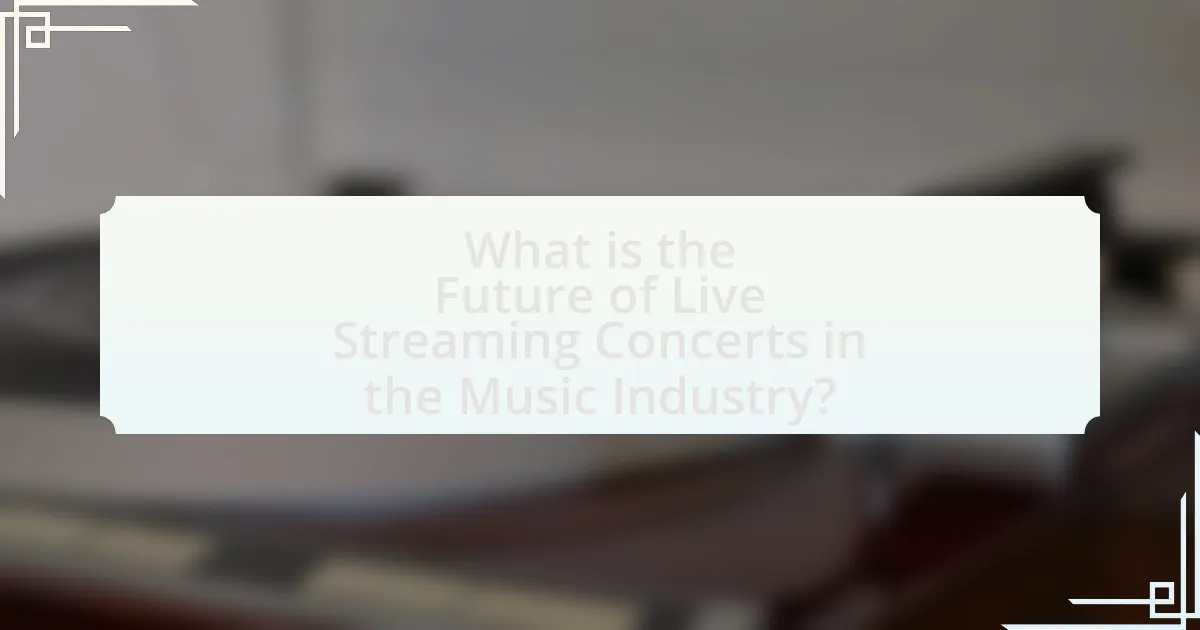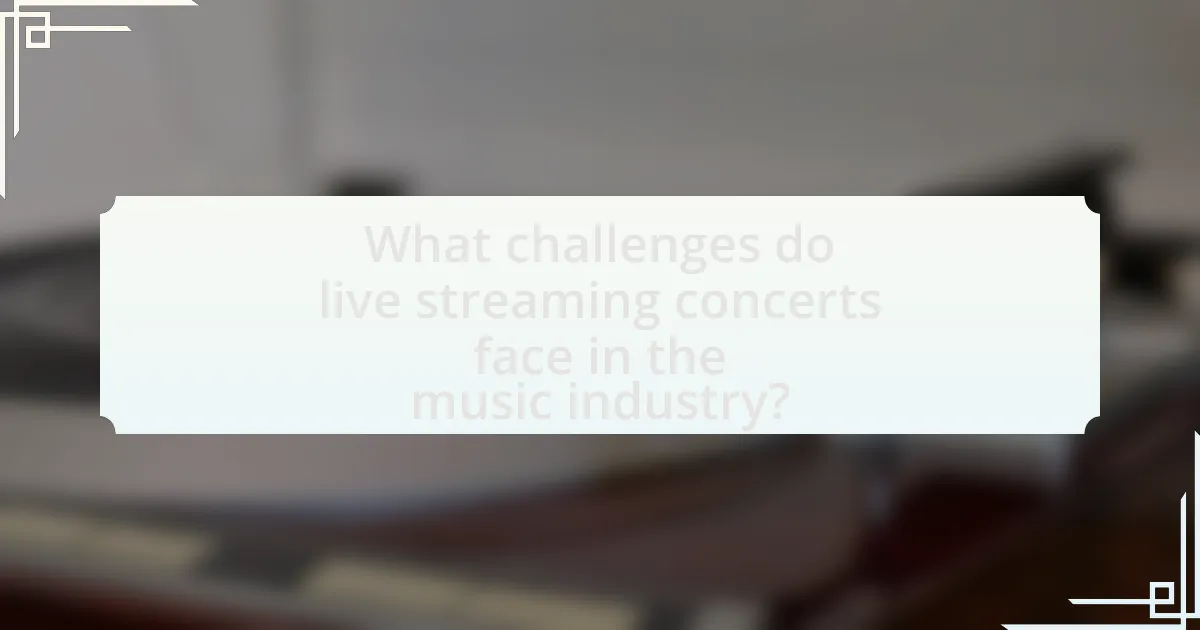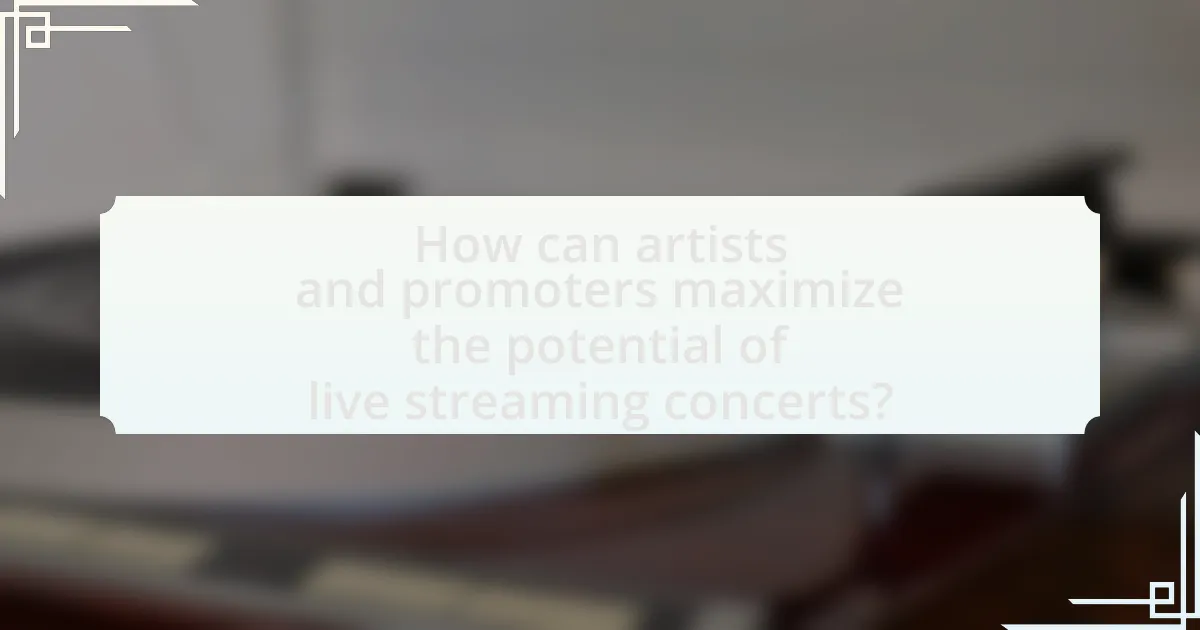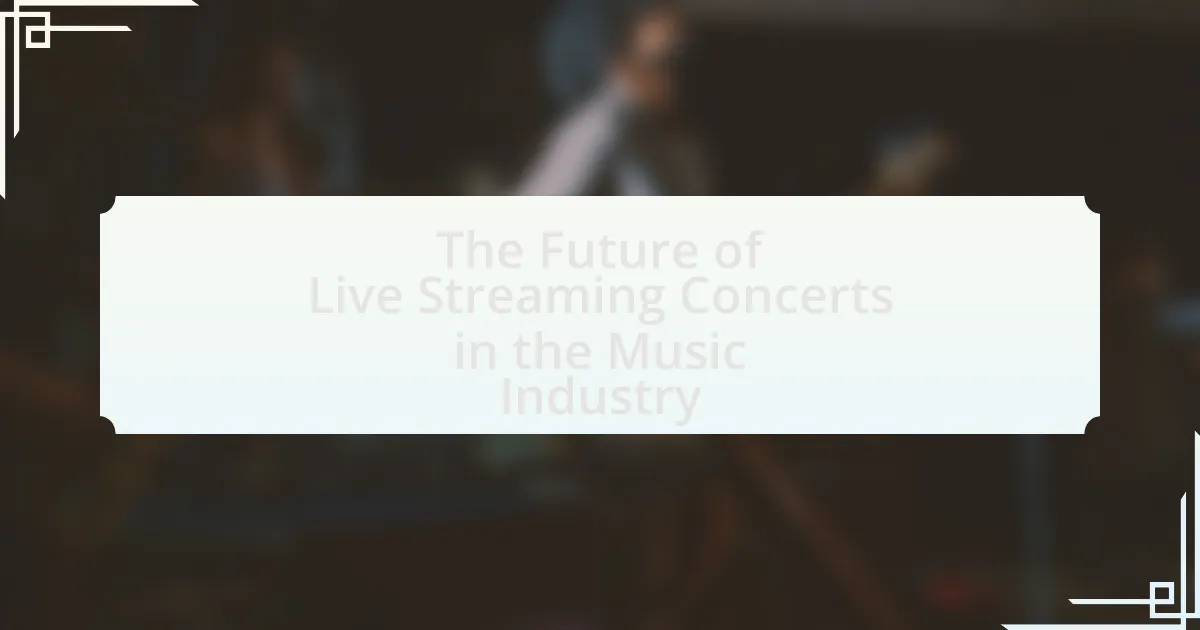The article examines the future of live streaming concerts in the music industry, highlighting significant growth driven by technological advancements and changing consumer preferences. With the global live streaming market projected to reach $247 billion by 2027, the article discusses how live streaming has transformed concert experiences by enhancing accessibility and audience engagement through interactive features. It also addresses the technological innovations enabling this shift, the differences between live streaming and traditional concerts, and the challenges artists face, including copyright issues and monetization difficulties. Key trends shaping the future, such as increased interactivity and the integration of augmented and virtual reality, are explored, along with strategies for artists and promoters to maximize the potential of live streaming concerts.

What is the Future of Live Streaming Concerts in the Music Industry?
The future of live streaming concerts in the music industry is poised for significant growth and innovation, driven by advancements in technology and changing consumer preferences. As of 2023, the global live streaming market is projected to reach $247 billion by 2027, indicating a strong demand for virtual concert experiences. This growth is fueled by the increasing accessibility of high-speed internet and the proliferation of streaming platforms, which allow artists to reach global audiences without geographical limitations. Additionally, the COVID-19 pandemic accelerated the adoption of live streaming, with platforms like Twitch and YouTube Live witnessing a surge in music-related content. Artists are now exploring hybrid models that combine in-person and virtual attendance, enhancing fan engagement and monetization opportunities. The integration of augmented reality (AR) and virtual reality (VR) technologies is also expected to transform the live streaming experience, offering immersive environments that replicate the excitement of physical concerts.
How has live streaming transformed the concert experience?
Live streaming has transformed the concert experience by making performances accessible to a global audience, allowing fans to attend virtually from anywhere. This shift has enabled artists to reach larger audiences beyond physical venue limitations; for instance, a study by Eventbrite in 2020 indicated that 80% of concertgoers expressed interest in attending virtual events. Additionally, live streaming has introduced interactive features such as real-time chat and virtual meet-and-greets, enhancing audience engagement. The COVID-19 pandemic accelerated this trend, with platforms like YouTube and Twitch hosting numerous live-streamed concerts, demonstrating the viability and popularity of this format.
What technological advancements have enabled live streaming concerts?
Technological advancements that have enabled live streaming concerts include high-speed internet, advanced video compression technologies, and interactive streaming platforms. High-speed internet allows for seamless transmission of high-definition video and audio, essential for delivering quality live performances to remote audiences. Advanced video compression technologies, such as H.264 and H.265, reduce the bandwidth required for streaming without compromising quality, making it feasible for more users to access live events. Interactive streaming platforms, like Twitch and YouTube Live, provide tools for real-time audience engagement, enhancing the concert experience and allowing for features like live chats and virtual meet-and-greets. These advancements collectively facilitate the growth and accessibility of live streaming concerts in the music industry.
How do live streaming concerts differ from traditional concerts?
Live streaming concerts differ from traditional concerts primarily in their accessibility and audience reach. Traditional concerts are limited by physical location, requiring attendees to be present at a specific venue, while live streaming concerts can be accessed globally, allowing viewers from anywhere to participate in real-time. According to a report by Statista, the global live streaming market is projected to reach $247 billion by 2027, highlighting the growing trend and demand for virtual events. Additionally, live streaming concerts often incorporate interactive features such as live chats and social media integration, enhancing audience engagement compared to the more passive experience of traditional concerts.
What are the key trends shaping the future of live streaming concerts?
Key trends shaping the future of live streaming concerts include increased interactivity, enhanced technology, and the integration of virtual reality. Interactivity allows audiences to engage with performers through real-time chats and polls, fostering a sense of community. Enhanced technology, such as 4K streaming and spatial audio, improves the viewing experience, making it more immersive. The integration of virtual reality creates opportunities for fully immersive concert experiences, allowing fans to feel as if they are physically present at the event. These trends are supported by data indicating that the global live streaming market is projected to grow significantly, reaching $247 billion by 2027, highlighting the increasing demand for innovative concert experiences.
How is audience engagement evolving in live streaming concerts?
Audience engagement in live streaming concerts is evolving through increased interactivity and personalization. Platforms now offer features such as real-time chat, polls, and virtual meet-and-greets, allowing viewers to interact directly with artists and each other. According to a report by Midia Research, 70% of fans prefer interactive experiences during live streams, highlighting the demand for engagement beyond passive viewing. Additionally, the integration of augmented reality (AR) and virtual reality (VR) technologies is enhancing the immersive experience, making audiences feel more connected to the performance. This shift towards a more participatory model is reshaping how artists and fans connect in the digital space.
What role do social media platforms play in live streaming concerts?
Social media platforms serve as critical channels for promoting and broadcasting live streaming concerts, significantly enhancing audience reach and engagement. These platforms enable artists to connect with fans in real-time, facilitating immediate interaction through comments and reactions, which fosters a sense of community. For instance, platforms like Facebook and Instagram have integrated live streaming features that allow artists to host virtual concerts, attracting millions of viewers globally. According to a report by Statista, in 2021, 67% of surveyed users indicated they had watched a live stream on social media, highlighting the effectiveness of these platforms in reaching large audiences. Additionally, social media facilitates targeted marketing through algorithms that promote events to users based on their interests, further increasing attendance and participation in live streaming concerts.

What challenges do live streaming concerts face in the music industry?
Live streaming concerts face several challenges in the music industry, including technical issues, audience engagement, and monetization difficulties. Technical issues such as poor internet connectivity can lead to buffering and low-quality streams, negatively impacting viewer experience. Audience engagement is also a challenge, as the lack of physical presence makes it harder for artists to connect with fans, leading to lower emotional investment. Additionally, monetization remains complex; artists often struggle to generate revenue comparable to traditional concerts due to reliance on ticket sales and sponsorships, which are less effective in a virtual format. These challenges highlight the need for innovative solutions to enhance the live streaming concert experience.
How do copyright issues impact live streaming concerts?
Copyright issues significantly impact live streaming concerts by restricting the use of copyrighted music and performances without proper licensing. Artists and platforms must obtain licenses from copyright holders, such as record labels and songwriters, to legally stream performances. Failure to secure these licenses can result in legal action, including fines and the removal of content. For instance, the U.S. Copyright Act mandates that streaming services must pay royalties for the use of copyrighted material, which can complicate the financial viability of live streaming concerts. Additionally, platforms like YouTube and Facebook have implemented automated systems to detect and block unauthorized content, further emphasizing the importance of compliance with copyright laws in the live streaming landscape.
What are the legal considerations for artists and platforms?
Artists and platforms must navigate copyright laws, licensing agreements, and liability issues when engaging in live streaming concerts. Copyright laws protect the original works of artists, requiring platforms to obtain licenses for music use to avoid infringement. Additionally, platforms must ensure compliance with performance rights organizations, which manage royalties for artists. Liability considerations include ensuring that content does not violate any laws or regulations, which could lead to legal repercussions for both artists and platforms. For instance, the U.S. Copyright Act mandates that platforms secure the necessary permissions to stream copyrighted material, highlighting the importance of legal compliance in the digital music landscape.
How can artists protect their intellectual property during live streams?
Artists can protect their intellectual property during live streams by utilizing copyright notices, digital rights management (DRM) technologies, and watermarking their content. Copyright notices inform viewers that the content is protected, deterring unauthorized use. DRM technologies restrict the copying and distribution of the stream, ensuring that only authorized viewers can access it. Watermarking embeds identifying information into the stream, making it easier to trace and prove ownership in case of infringement. These measures are essential as they help maintain the integrity of the artist’s work and provide legal recourse against unauthorized use.
What technical challenges must be addressed for successful live streaming?
Successful live streaming requires addressing several technical challenges, including bandwidth limitations, latency issues, and video quality optimization. Bandwidth limitations can hinder the ability to transmit high-quality video and audio, leading to buffering and interruptions. Latency issues affect real-time interaction between performers and audiences, which is crucial for live events. Video quality optimization is essential to ensure that the stream remains clear and engaging, even under varying network conditions. According to a report by Cisco, video traffic will account for 82% of all consumer internet traffic by 2022, highlighting the importance of addressing these challenges to meet audience expectations and enhance the overall experience.
How does internet bandwidth affect live streaming quality?
Internet bandwidth directly impacts live streaming quality by determining the amount of data that can be transmitted over a connection at any given time. Higher bandwidth allows for smoother video playback, reduced buffering, and better overall resolution, while lower bandwidth can lead to pixelation, lag, and interruptions. For instance, streaming platforms typically recommend a minimum bandwidth of 3 Mbps for standard definition and 25 Mbps for high definition streaming to ensure optimal performance. This correlation between bandwidth and streaming quality is supported by data from various studies, which indicate that inadequate bandwidth can significantly degrade the viewer experience during live events.
What solutions exist for overcoming technical difficulties in live streaming?
To overcome technical difficulties in live streaming, solutions include using reliable streaming platforms, ensuring high-quality internet connections, and employing professional audio-visual equipment. Reliable streaming platforms, such as OBS Studio or StreamYard, provide stability and user-friendly interfaces, which reduce the likelihood of interruptions. High-quality internet connections, ideally with a wired Ethernet setup, minimize latency and buffering issues, as studies indicate that a stable connection significantly enhances viewer experience. Additionally, professional audio-visual equipment, including high-definition cameras and microphones, ensures that the content is visually and audibly appealing, which is crucial for maintaining audience engagement during live streaming events.

How can artists and promoters maximize the potential of live streaming concerts?
Artists and promoters can maximize the potential of live streaming concerts by leveraging high-quality production, engaging with audiences through interactive features, and utilizing targeted marketing strategies. High-quality production enhances the viewing experience, as evidenced by studies showing that 70% of viewers are more likely to engage with content that has superior audio and visual quality. Interactive features, such as live chats and polls, foster audience participation, which can increase viewer retention and satisfaction. Additionally, targeted marketing strategies, including social media promotions and collaborations with influencers, can significantly expand reach; for instance, a successful campaign can increase ticket sales by up to 30%. By focusing on these elements, artists and promoters can effectively enhance the impact and profitability of live streaming concerts.
What strategies can artists use to promote their live streaming concerts?
Artists can promote their live streaming concerts by leveraging social media platforms, engaging with fans through interactive content, and utilizing email marketing campaigns. Social media platforms like Instagram, Facebook, and Twitter allow artists to reach a broad audience, with 54% of users reporting they use these platforms to discover new music. Engaging content, such as behind-the-scenes videos or Q&A sessions, fosters a connection with fans, increasing anticipation for the concert. Additionally, email marketing campaigns can effectively inform existing fans about concert details, with studies showing that email marketing has an average ROI of $42 for every dollar spent. These strategies collectively enhance visibility and drive attendance for live streaming concerts.
How can collaborations enhance the reach of live streaming events?
Collaborations can significantly enhance the reach of live streaming events by leveraging the combined audiences and resources of multiple partners. When artists, brands, or influencers collaborate, they tap into each other’s fan bases, resulting in increased visibility and engagement. For instance, a study by Eventbrite found that events featuring multiple artists or brands can attract up to 50% more viewers compared to solo performances. This expanded audience not only boosts live viewership but also enhances social media sharing, as fans are more likely to promote events that feature their favorite artists or brands.
What marketing techniques are most effective for live streaming concerts?
Effective marketing techniques for live streaming concerts include social media promotion, influencer partnerships, and targeted email campaigns. Social media platforms like Instagram and Facebook allow artists to reach large audiences quickly, with 54% of users expressing interest in live streaming events according to a 2021 survey by Eventbrite. Influencer partnerships can amplify reach, as influencers can engage their followers and create buzz around the event. Additionally, targeted email campaigns can effectively inform existing fan bases about upcoming concerts, with studies showing that personalized emails can increase engagement rates by up to 29%. These techniques collectively enhance visibility and drive attendance for live streaming concerts.
What best practices should be followed for a successful live streaming concert?
To ensure a successful live streaming concert, it is essential to prioritize high-quality audio and video production. High-quality audio is crucial because poor sound can detract from the viewer’s experience, leading to negative feedback and reduced engagement. According to a study by the International Federation of the Phonographic Industry, 70% of viewers cite sound quality as a key factor in their enjoyment of live streams. Additionally, a stable internet connection is vital to prevent interruptions, as buffering can lead to viewer frustration and drop-offs. Engaging with the audience through real-time interactions, such as live chats or social media integration, enhances the experience and fosters a sense of community. Furthermore, promoting the event across multiple platforms before the concert can significantly increase viewership, as evidenced by a report from Eventbrite, which states that events with robust marketing strategies see up to 50% higher attendance. Lastly, rehearsing the performance and testing all technical aspects beforehand can help identify potential issues, ensuring a smooth delivery on the day of the concert.
How can artists create an engaging experience for virtual audiences?
Artists can create an engaging experience for virtual audiences by utilizing interactive technologies and immersive content. For instance, incorporating live chat features allows audiences to communicate in real-time, enhancing their sense of participation. Additionally, using high-quality visuals and sound can replicate the atmosphere of a live concert, making the experience more captivating. Research indicates that 70% of viewers prefer interactive elements during virtual events, which supports the effectiveness of these strategies in maintaining audience engagement.
What tools and platforms are recommended for live streaming concerts?
Recommended tools and platforms for live streaming concerts include OBS Studio, Streamlabs, YouTube Live, Facebook Live, and Twitch. OBS Studio is a free and open-source software that allows for high-quality video streaming and is widely used by musicians for its flexibility and customization options. Streamlabs enhances the streaming experience with integrated alerts and donation features, making it popular among performers. YouTube Live and Facebook Live provide extensive reach due to their large user bases, allowing artists to connect with fans easily. Twitch, originally a gaming platform, has expanded to include music streams, offering a community-focused environment for artists. These platforms are validated by their widespread adoption in the industry, with many successful live streaming events hosted on them, demonstrating their effectiveness in reaching audiences.
What are the future prospects for live streaming concerts in the music industry?
The future prospects for live streaming concerts in the music industry are highly promising, driven by advancements in technology and changing consumer behavior. As of 2023, the global live streaming market is projected to reach $247 billion by 2027, indicating a significant growth trajectory. This growth is fueled by the increasing accessibility of high-speed internet and the proliferation of mobile devices, allowing audiences to engage with live performances from anywhere in the world. Additionally, artists and promoters are recognizing the potential for revenue generation through ticket sales, merchandise, and sponsorships in virtual environments. The success of platforms like Twitch and YouTube Live demonstrates the viability of live streaming as a mainstream concert format, further solidifying its role in the future of the music industry.
How might audience preferences evolve in the coming years?
Audience preferences in live streaming concerts are likely to evolve towards greater interactivity and personalization. As technology advances, audiences will increasingly seek immersive experiences that allow them to engage with artists and other fans in real-time. For instance, platforms like Twitch and YouTube Live have already begun integrating features such as live chats, polls, and virtual meet-and-greets, which enhance viewer participation. Additionally, data from a 2022 report by Midia Research indicates that 60% of music fans prefer live streaming events that offer unique content, such as behind-the-scenes access or exclusive performances, suggesting a shift towards more tailored experiences. This trend indicates that future audience preferences will prioritize engagement and personalization in live streaming concerts.
What innovations could further enhance live streaming concert experiences?
Innovations such as augmented reality (AR), virtual reality (VR), and interactive streaming platforms could significantly enhance live streaming concert experiences. AR can overlay digital elements onto the real-world view, allowing viewers to engage with the performance in a more immersive way. VR can create a fully immersive environment, enabling fans to feel as if they are physically present at the concert, regardless of their actual location. Interactive streaming platforms can facilitate real-time audience participation, such as voting on setlists or interacting with artists through live chats, which can increase viewer engagement and satisfaction. These technologies have been shown to improve user experience in various entertainment sectors, indicating their potential effectiveness in live streaming concerts.

Leave a Reply